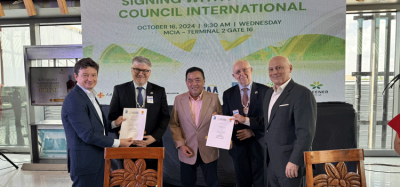How ICAO is making climate change a priority issue
- Like
- Digg
- Del
- Tumblr
- VKontakte
- Buffer
- Love This
- Odnoklassniki
- Meneame
- Blogger
- Amazon
- Yahoo Mail
- Gmail
- AOL
- Newsvine
- HackerNews
- Evernote
- MySpace
- Mail.ru
- Viadeo
- Line
- Comments
- Yummly
- SMS
- Viber
- Telegram
- Subscribe
- Skype
- Facebook Messenger
- Kakao
- LiveJournal
- Yammer
- Edgar
- Fintel
- Mix
- Instapaper
- Copy Link
Posted: 1 August 2008 | Jane Hupe, Chief of the ICAO Environmental Unit and Secretary for the ICAO Council Committee on Aviation Environmental Protection (CAEP) | No comments yet
The effects of international aviation on the environment have been a concern to ICAO for more than 40 years. The first ICAO Standards and Recommended Practices (SARPs) for noise were adopted in 1971 and for aircraft engine emissions in 1981, long before the average air traveller was introduced to the concepts of “carbon footprint” and “offset-programmes”.
The effects of international aviation on the environment have been a concern to ICAO for more than 40 years. The first ICAO Standards and Recommended Practices (SARPs) for noise were adopted in 1971 and for aircraft engine emissions in 1981, long before the average air traveller was introduced to the concepts of “carbon footprint” and “offset-programmes”.
Climate change has been characterized as one of the greatest challenges of this century. To address this challenge it would be essential to reduce and stabilize greenhouse gas (GHG) emissions to a level that does not endanger the global climate and to put in place steps to cope with the inevitable impacts over the coming decades. Negotiations are taking place under the United Nations to identify the best way forward and to define the specific roles of all of those involved in achieving this goal. An effective programme of action to address climate change will need to encompass all countries and activities, while considering their specific needs and respecting their overriding priorities for sustainable development.
Emissions from aviation are part of this equation. The fact that the aviation sector (domestic and international operations) currently accounts for approximately 2% of total CO2 emissions should not detract from the need for immediate action. This is particularly necessary in the face of expected significant growth in aviation activities in the future.
To address these emissions, however, a clear understanding of the technical, economic, legal and social implications of the various possible measures is necessary, as aviation is a major catalyst of economic development and an important pillar of the achievement of the millennium goals.
Parallel tracks
Both international aviation and climate change are not restricted to national boundaries. They are global issues and therefore action only makes sense if taken through a concerted approach at the international level. Towards this end, the international community adopted two major Conventions to deal with these subjects: the first one, in 1944, the Convention on International Civil Aviation, also known as the Chicago Convention, and in 1992 (Rio Summit) the United Nations Framework Convention on Climate Change (UNFCCC).
Both of these Conventions have parties from close to 200 States and have, since entering into force, been complemented by other legal instruments taking the form of Annexes, Agreements or Protocols.
In the case of ICAO, Annex 16 to the Chicago convention deals with Standards and Recommended Practices to address environmental protection (with a volume entirely dedicated to aircraft engine emissions). ICAO has also developed studies, guidance and policies to reduce aviation emissions based on three approaches: reduction of emissions at source through technology innovation (cleaner and more efficient engines and airframes) reduction of emissions through operational measures (e.g. more efficient air traffic management) and through market based measures. Studies identified an open and global emissions trading system as the most efficient market measure to address aviation emissions and ICAO has since developed specific guidance on the matter – ICAO Guidance on the use of Emissions Trading for Aviation (Doc 9885).
The last ICAO Assembly Session was held in September 2007 and all Contracting States agreed on a comprehensive plan of action comprising four major elements:
- The regular assessment of the impact of aviation on the environment and the continued development of tools for this purpose
- The vigorous development of policy options to limit or reduce the environmental impact of aircraft engine emissions and the provision of advice as soon as possible to the Conference of the Parties of UNFCCC on technical solutions and market-based measures
- The continued development and updating, through CAEP, of standards and guidance for Contracting States, on the application of measures aimed at reducing or limiting the environmental impact of engine emissions
- The formation of a new group to develop and recommend to ICAO an aggressive Programme of Action on International Aviation and Climate Change. This high-level group, known as GIACC, is composed of senior government officials representative of all ICAO regions, with the equitable participation of developing and developed States. The work of GIACC is done through an inclusive process and will involve consultation with all stakeholders. GIACC held its first meeting in February 2008 in Montréal and its second was held in July. In all, four meetings are planned, following which the Council of ICAO will convene a high level meeting to review the Programme of Action recommended by GIACC.
The 36th Session of the ICAO Assembly specifically requested that this high-level meeting be held at a time which would take into account the fact that the 15th meeting of the Conference of the Parties (COP 15) that UNFCCC will hold in December 2009 in Copenhagen.
Regarding the UNFCCC, in December 1997, an agreement was reached on the Kyoto Protocol to the Convention. The Kyoto Protocol includes legally binding emission reduction targets for developed countries (Annex I Parties) for the period 2008-2012. Emissions from domestic aviation are included in the total emissions reported and subject to the above targets. Emissions from international aviation are reported separately and are excluded from national totals, hence being excluded form the Kyoto targets. Instead, Article 2.2 of the Kyoto Protocol provides for addressing these emissions working through ICAO.
The Intergovernmental Panel of Climate Change (IPCC), the leading body charged with the responsibility to assess climate change science, published its Fourth Assessment Report in 2007 and brought new momentum to the climate negotiations. The report gave a clear signal that climate change is happening and accelerating, that much of it is caused by the continued and increasing emissions of greenhouse gases from human activities and that it can have severe impacts.
The IPPC report brought a sense of urgency into the UN climate change negotiations and at the Climate Change Conference in Bali in December 2007, all Parties to the UNFCCC agreed on the Bali Road Map to advance ongoing work on key issues. Parties decided to launch formal negotiations on a deal on long-term cooperative action. These negotiations are set to be concluded by the end of 2009 at the Climate Change Conference in Copenhagen, in order to ensure continuity and stability in the current efforts to address climate change.
In a very intrinsic way, ICAO and UNFCCC have set up two separate but parallel streams of activity, which will culminate at the end of 2009. While this is challenging to both organizations, it also provides a unique opportunity for consultation and cooperation. Both organizations are moving in the same general direction, debating similar issues and setting their sights on likewise similar outcomes. It is therefore imperative to strengthen coordination and join forces to increase the effectiveness of both organizations and identify what needs to be implemented in order to ensure that aviation emissions continue to be addressed effectively in the future. This would be in the best interest of all stakeholders, as matters related to international aviation and to climate change have implications for all Parties, independently of their development stage.
Ongoing activities and recent developments
Since the last Assembly Session and the inception of the GIACC, the ICAO Council requested the Organization’s Committee on Aviation Environmental Protection (CAEP) to prioritize and intensify all activities related to greenhouse gas emissions (GHG). These include assessment of GHG emissions, more stringent NOx standards for aircraft engines, fuel burn goals and metrics, operational measures to reduce global emissions, and market-based measures. It also requested CAEP to prioritize input requested by GIACC, so as to meet the deadline of 2009 for the GIACC to develop an ICAO Programme of Action on Aviation Emissions.
ICAO is making progress with the building blocks of the Programme and is actively preparing for the second meeting of the GIACC. To ensure that their policy decisions are based on the best available information, ICAO has solicited information from its Contracting States on their aviation GHG emissions. ICAO has also extended an invitation to the UNFCCC Secretariat to participate in the second meeting of the GIACC.
Also, with a view to enable short term action and to ensure that all potential solutions to deal with the growth of aviation emissions are explored, ICAO has developed and recently launched the ICAO Carbon Calculator for use in carbon-offsetting programmes. It is a transparent and internationally-approved web-based tool to identify the amount of carbon dioxide (CO2) emissions from a given flight available at www.icao.int. The Carbon Calculator responds to the wish of many travellers for a reliable and authoritative method to estimate the carbon footprint of a flight. Only publicly available and verifiable sources of information are used in the calculations The methodology used takes into account a range of variables such as aircraft type, route specific data, passenger load factors and cargo carried. After air travellers calculate the amount of CO2 they are responsible for, they can choose the programme best suited to offset the impact of their trips on climate change.
ICAO is now exploring the potential of offset programmes in addressing GHG emissions from aviation. Emissions from air travel currently form the bulk of the emissions being offset by individuals through voluntary offset programmes. However, due to the lack of harmonization within these programmes, it is impossible to estimate the volume of emissions currently being offset or to account for them. This and other important market based measures were the focus of the ICAO Worksop on Aviation and Carbon Markets, held in ICAO in June 2008. Its purpose was to establish the current status of carbon markets throughout the world, highlighting areas where aviation is being considered and to stimulate an exchange of views. The programme of the workshop was designed to allow for free-flowing and transparent exchange of views with financial, industry and environmental experts. The participants addressed the key issues and challenges the aviation sector will need to address in tackling aviation emissions through the use of carbon markets.
The challenges ahead
The challenges ahead should not be underestimated. Although the aviation industry has recorded the substantial benchmark of producing aircraft today that are 70% more fuel efficient than 40 years ago, aviation’s environmental performance and that of ICAO remain under criticism. This is due partly to the fact that this remarkable technological achievement has not been enough to address the growth in volume of emissions produced by the increasing number of passengers and operations created by the public demand for travel. Thus, while efforts and commitments from many parties require the reduction of emissions to levels below those of 1990, total emissions from international aviation continue to grow.
Not having defined a baseline for the sector against which to measure reduction of emissions, nor a target defining the objective and schedule for future emissions reduction, leads to queries and dissatisfaction from the growing environmental conscientious public. This situation also tends to undermine many of the green initiatives of the sector which, with the lack of a baseline scenario to compare to, become characterized as business as usual or are not accounted for.
Part of the public concern with the environmental performance of aviation comes from the lack of clarity and accuracy on the information provided by ICAO regarding the current and future growth prospects of aviation emissions. The figures brought to the attention of the public do not convey clearly if they are State or region specific, from international or domestic aviation operations and usually quote non-authoritative sources or methodologies.
Much will be needed in terms of enhancing the outreach activities and defining how international aviation will participate in the next climate change regime. An effective programme of action to address international aviation will need to be based on reliable and authoritative information on current and future estimates of international aviation emissions taking into account realistic scenarios of the global economy. It will also need to include a basket of measures to effectively mitigate the adverse impacts of aviation on the global climate, and will need to include considerations on adaptation, financing and financial flows and technology transfer as key elements in addressing climate change.
Direct cooperation between the UNFCCC and the ICAO processes will be paramount but effective collaboration must also be encouraged within each of the respective Member States. In many cases, for example, there should be more communication between government authorities responsible for the environment and those responsible for civil aviation, so that the positions and proposals of Member States in international gatherings of ICAO and UNFCCC are better aligned so as to allow a more comprehensive view of a State’s policies and programmes. This will ultimately result in a true reflection of the will of the Parties to these processes.
Work and negotiations in the upcoming year and half will be intense, challenging and highly demanding. We will need to enhance our efforts, be more creative and take note of the spirit of cooperation that is needed to address the challenges we are facing. We will need to ensure that we keep on the right track and that all the road maps, although taking alternative paths, will converge in Copenhagen.


















